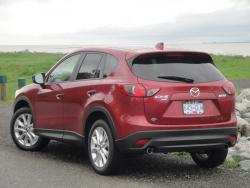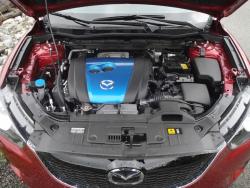 2012 Honda CR-V Touring (top); 2013 Mazda CX-5 GT. Click image to enlarge |
| Related Articles: Comparison Test: Five Compact CUVs Comparison Test: Compact CUVs, Round 2 Test Drive: 2012 Honda CR-V Touring Test Drive: 2013 Mazda CX-5 GT Manufacturer’s websites: |
Originally published on June 27, 2012
Review by Paul Williams
CR-V photos by Paul Williams; CX-5 photos by Greg Wilson
Photo Gallery:
2012 Honda CR-V
2013 Mazda CX-5
Canadians like compact CUVs; a vehicle type that offers an excellent combination of practicality, fuel efficiency, value, and choice. Consequently, all mainstream manufacturers have competitive models in this popular segment, but with their similar shapes and attributes, consumers could be forgiven for wondering if there’s any real variation between them.
Here’s a tale of two compact CUVs that, superficially, may seem very much alike. The 2013 Mazda CX-5 and the 2012 Honda CR-V are both all new this year (in the case of the Mazda, it’s a completely new model; Honda’s is a new generation). They’re both available with front-wheel drive or all-wheel drive, both have four-cylinder engines and automatic transmissions, they’re similarly sized and similarly priced. So what’s the difference?
Lots, actually, but not much that necessarily jumps out by looking down the list of available and standard features. No, the differences have more to do with the intangibles; the overall character of the vehicles. Just like people, they have their ways.
  2012 Honda CR-V Touring (top; photo by James Bergeron); 2013 Mazda CX-5 GT. Click image to enlarge |
Recently I spent quite a bit of time in the GT version of the CX-5, and the Touring version of the CR-V. These are the top models available, and are priced accordingly at $32,495 and $35,090 respectively. I hauled people, groceries, some furniture, a set of wheels and tires, wine, woman and song (on the radio…) over a two-week period. It was a real-world experience where the “utility” of these compact Crossover Utility Vehicles was put to the test, along with their drivability and fuel economy.
And it wasn’t a planned test… it was coincidental. I just happened to drive these vehicles back-to-back, with places to go and errands to run. Because of that, their similarities and differences became more obvious. And I started thinking,
“What’s the essence of the difference between them?”
The Mazda builds on its “zoom-zoom” branding by including sporty touches like contrasting red stitching in the black leather seats, an instrument panel reminiscent of the MX-5 sports car, a dual exhaust and large 19-inch alloy wheels. The performance appearance continues most obviously in the exterior design of the CX-5, which features swoopy lines and chiseled edges that suggest speed and vitality. It’s a sharp vehicle that looks like it might take you somewhere cool.
The Honda sends a different message. Its single exhaust, soft beige leather seating surfaces (in my test vehicle) and smaller 17-inch alloy wheels are more family oriented; targeted away from the enthusiast buyer. The message is more about practicality and comfort, with the CR-V’s exterior design looking sleek but conservative. The CR-V looks like it’s ready to give you a hand.
  2012 Honda CR-V Touring (top; photo by Jonathan Yarkony); 2013 Mazda CX-5 GT. Click image to enlarge |
Standard features are similar. Both the Honda CR-V Touring and the Mazda CX-5 GT are equipped with leather upholstery, all-wheel drive, automatic climate control, premium trim, auto-dimming rear view mirror, remote keyless entry, Bluetooth connectivity, roof rails, alloy wheels, and a full power group.
There are differences under the hood, though. The Mazda CX-5 features Mazda’s new “Skyactiv” technology designed to provide a sporty driving experience and excellent fuel economy. The engine, the transmission, and the chassis have each been optimized for good handling and low fuel consumption, and Mazda’s betting much of its future on the viability of this technology as an alterative to developing a hybrid (although a diesel CX-5 is rumoured).
The Mazda’s 2.0L, four-cylinder engine makes 155 horsepower and 150 lb-ft of torque, and is mated to a new six-speed automatic transmission. The all-wheel drive CX-5 is estimated to consume 8.0/6.4 L/100km, city/highway, which is indeed excellent for a vehicle of this type.
The Honda uses an updated version of its 2.4L four-cylinder engine that makes 185 hp and 163 lb-ft torque. It’s mated to a five-speed automatic transmission and has an official fuel consumption rating of 9.2/6.6 L/100km, city/highway. These also are very competitive numbers.









